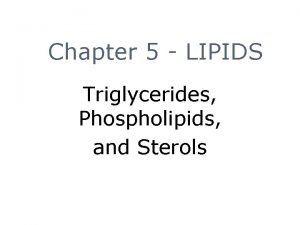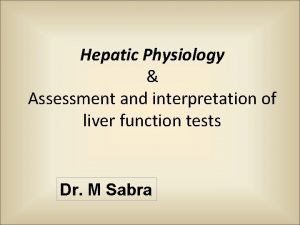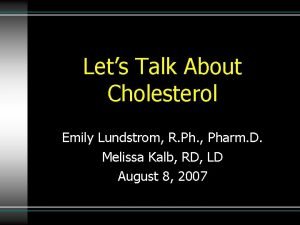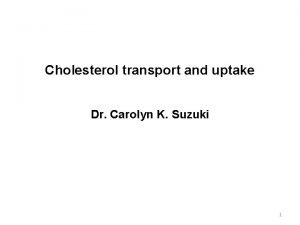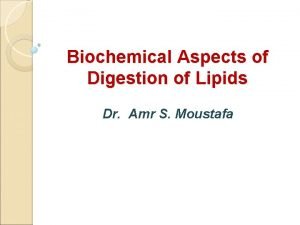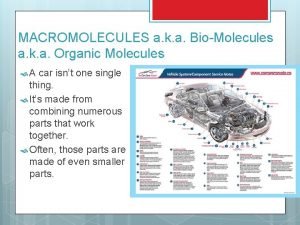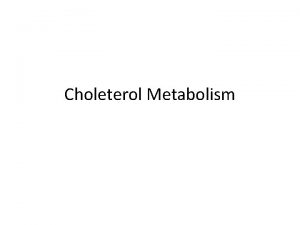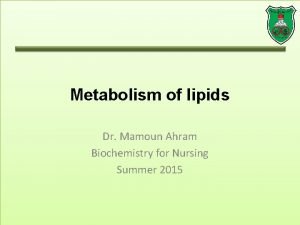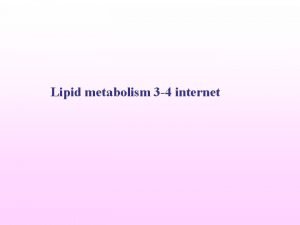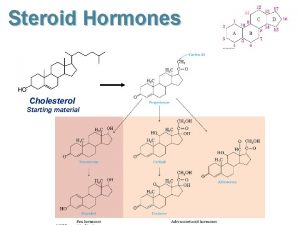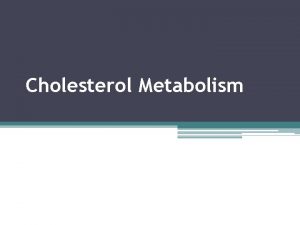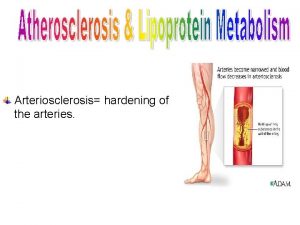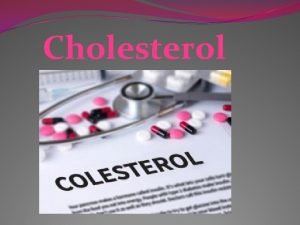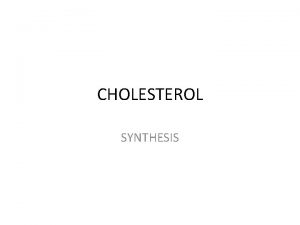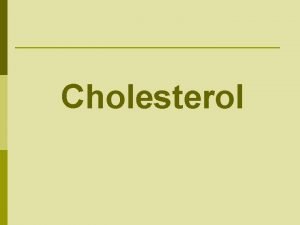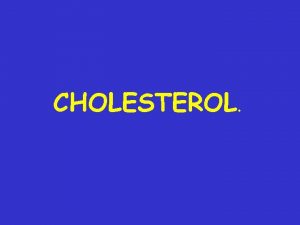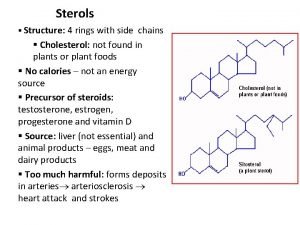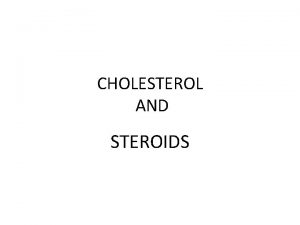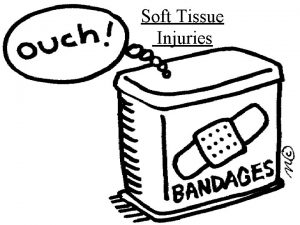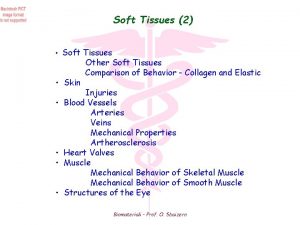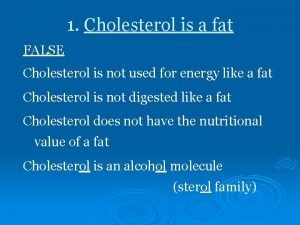STEROLS CHOLESTEROL What is Cholesterol Cholesterol A soft
















- Slides: 16

STEROLS: CHOLESTEROL

What is Cholesterol? Cholesterol: ➢ A soft waxy substance made naturally in our bodies ➢ Rigid molecule that helps solidify cell walls ➢ Up to 25% of wall is cholesterol ➢ Insoluble in water ➢ It helps to form or repair cell membranes, some hormones, vitamin D and other tissues.

Where does it comes from? The two sources of cholesterol are the 1. Liver 2. Food The body produces 80% of the cholesterol it needs. � Manufactured by the liver The remaining 20% comes from the food we eat.

Why is management of cholesterol important?

Research has shown: � There is a relationship between high blood cholesterol levels and heart disease. � Cholesterol is transported throughout the body by LIPOPROTEINS � Clusters of lipid & protein molecules

HDL: High-Density Lipoprotein High-density lipoproteins (HDL) carry cholesterol from the blood back to the liver, which processes the cholesterol for elimination from the body. � HDL makes it less likely that excess cholesterol in the blood will be deposited in the coronary arteries � HDL cholesterol is often known as the "good" cholesterol.

LDL: Low-Density Lipoprotein Low-density lipoproteins (LDL) carry cholesterol from the liver to the rest of the body � When there is too much LDL cholesterol in the blood, it can be deposited on the walls of the coronary arteries. � � LDL cholesterol is often known as the "bad" cholesterol.

SATURATED UNSATURATED Lowers blood cholesterol levels Raises blood cholesterol levels - If there is at least one double carbonto-carbon bond, the fatty acid is unsaturated. - Monounsaturated - A fatty acid with one double bond is monounsaturated Ex: olive oil - Polyunsaturated - A fatty acid with two or more double bonds. Ex: corn oil, soybean oil -When all the bonds between the carbons are single, the fatty acid is saturated. Ex: Coconut & palm oil, butter, bacon, eggs, sour cream, aged cheeses, whole milk - Diets high in sat. fat & cholesterol reduce lliver's demand for circulating LDL= higher blood levels and greater deposition of cholesterol in vessels. -Animal fat: higher in sat. fatty acids.

Plaque: � Deposits of LDL cholesterol can build up inside arteries � Can narrow an artery enough to slow or block blood flow.

Atherosclerosis � Hardening and narrowing of the arteries is known as the heart disease, atherosclerosis

Who is in greater DANGER?

Prevalence of cardiovascular disease in adults ≥ 20 years of age by age and sex (National Health and Nutrition Examination Survey: 2005– 2008). Copyright © American Heart Association

Factors Affecting Cholesterol Controllable � Diet. � Saturated fat and cholesterol in the food you eat increase cholesterol levels. Try to reduce the amount of saturated fat and cholesterol in your diet. � Weight. � In addition to being a risk factor for heart disease, being overweight can also increase cholesterol. Losing weight can help lower your LDL and total cholesterol levels, as well as increase HDL cholesterol. � Exercise. � Regular exercise can lower LDL cholesterol and raise HDL cholesterol. You should try to be physically active for at least 30 minutes on most days. Uncontrollable � Age and Gender. � As we get older, cholesterol levels rise. Before menopause, women tend to have lower total cholesterol levels than men of the same age. After menopause, however, women's LDL levels tend to rise. � Diabetes. � Poorly controlled diabetes increases cholesterol levels. With improvements in control, cholesterol levels can fall. � Heredity. � Your genes partly determine how much cholesterol the body makes. � Other causes. � Certain medications and medical conditions

Fats and Oils to Choose Heart disease is low among Mediterranean regions: OLIVE OIL (high in unsaturated fatty acids) Polyunsaturated: Lower LDL but may also Lower HDL Monounsaturated: Lower LDL without lowering HDL • CANOLA AND OLIVE OIL

Trans FAT Increases LDL or bad cholesterol Required to be on nutrition labels Typically found in foods that are fried or that contain margarine or shortening. Ex. Snack crackers, donuts, chips, chocolate chip cookies, taco shells, muffin mix, and margarine. Reducing overall dietary fat is the best way to reduce intake of trans fatty acids. Reducing reliance on shortening and margarine also is beneficial ** FDA finally has banned but it will be a transition. . . Stephen Colbert’s take on trans fats…

Expand & Check Your Knowledge: Conscious About Cholesterol Assignment
 Triglycerides phospholipids and sterols
Triglycerides phospholipids and sterols Cholesterol homeostasis
Cholesterol homeostasis Emily lundstrom
Emily lundstrom Cholesterol uptake
Cholesterol uptake Hugh cholesterol
Hugh cholesterol Lipid digestion enzymes
Lipid digestion enzymes Fats subunits
Fats subunits Ldl-c
Ldl-c Choleterol
Choleterol Good and bad cholesterol
Good and bad cholesterol Hdl ldl
Hdl ldl Steroids and cholesterol
Steroids and cholesterol Non polar molecules that include fats oils and cholesterol
Non polar molecules that include fats oils and cholesterol Cholesterol homeostasis
Cholesterol homeostasis Cholesterol treatment trialists collaboration
Cholesterol treatment trialists collaboration A dietitian wishes to see if a person's cholesterol
A dietitian wishes to see if a person's cholesterol Atorvastatin lactone
Atorvastatin lactone
